Rugged Mountain RV refines its ultimate non-slide flatbed camper formula with a new 12-foot model. With a huge dry bath, enormous storage capacity, and bleeding-edge battery, solar, and electrical systems, the X12 is a statement product.

Last February, Rugged Mountain launched the production X14 and utterly destroyed the notion that a hard side non-slide couldn’t compete with double and even triple-slide truck campers for floor space, capacity, storage, and functionality.
The catch? The X14 is a 14-foot flatbed. The solution? Get yourself a Class 5 Ford F-550, Ram 5500, or Chevy 5500, add an 11-foot flatbed, and let the hard side non-slide monster truck camper times roll. Triple-slide slide-ins eat your heart out.
Where the X14 succeeded in being the longest flatbed, that’s also where it could fall short for some folks. Again and again, Rugged Mountain received praise for the X14’s concept, design, and capabilities, and heard request after request for a shorter version.
To answer these requests, Rugged Mountain has created the X12. By reeling in the X14’s three-foot overhang by two feet, towing no longer requires an extended hitch, the rig becomes a bit more maneuverable, and the ferry-by-the-foot charge becomes a little more affordable. The X12 still requires a serious truck and flatbed, but the size and length are now closer to the truck camper standard and comfort zone.
What’s most impressive is that the X12 retains the enviable tank capacities, battery capacities, and high-end features of the X14. And both the X14 and the X12 match Rugged Mountain’s triple-slide Denali 3S tank for tank, battery for battery, and system for system. Put another way, you don’t need three slides or a 14-foot floor length to get 100 percent of Rugged Mountain’s specs.
All of this wouldn’t mean a hoot if the X12 weren’t impressive in its own right. On that front, the X12 has exactly the same dinette and cabover as the X14. And if you think they took those two feet out of the bathroom, think again. The X12 has a huge dry bath; easily one of the biggest, if not the biggest, in the marketplace. Yes, a bit of storage didn’t make the cut, but one would be hard pressed to say the X12 doesn’t offer plenty in that department.
So just how did Rugged Mountain cut two feet off the X14 to create the X12? Is this some kind truck camper sorcery? To find out, we talked to Jesse Collinsworth, Founder and CEO of Rugged Mountain RV.
 Rugged Mountain X12 Specifications:
Rugged Mountain X12 Specifications:
The 2026 Rugged Mountain X12 is a hard side, non-slide, dry bath flatbed truck camper. The interior floor length of the Rugged Mountain X12 is 11’9”, the interior width is 7’9”, the interior height is 6’7”, and the center of gravity is 49” from the front wall.
The X12 has an 80-gallon fresh tank, a 77-gallon grey tank, a 35-gallon black tank, and an on-demand diesel water heater. It can accommodate up to 1,350-amp hours of lithium and 1,200-watts of solar.
Rugged Mountain is reporting the base weight of the X12 at 4,935 pounds. The base cost of the 2026 Rugged Mountain X12 is $95,000.
Click here for an X12 brochure

Where did you get the idea that a flatbed truck camper was something the marketplace was looking for?
For years, I’ve had customers asking for a non-slide flatbed Rugged Mountain truck camper with the tank capacities and amenities of our triple-slide Denali 3S. Two of those customers were Jared and Candice of StableCamper. Eventually, Jared designed the X14 floor plan and presented it to me. I told him I’d build a prototype based on his design. If it worked and was well-received, it would become a Rugged Mountain model. The rest is history.
So it’s all Jared’s fault. Do you sense a shift towards non-slides in the high-end hard side marketplace? Our 2026 Hard Side Camper Survey Results point in this direction.
The shift I’m watching is toward flatbed truck campers. Of course, not everyone wants a bigger truck or a flatbed, but the market for flatbed truck campers is definitely growing.
The interest in non-slide truck campers is also accelerating. And nobody makes a non-slide truck camper with the interior room, tank capacities, and off-grid capabilities of a Rugged Mountain. We’re experiencing both trends at the same time.

The X14 is easily the largest non-slide demountable flatbed truck camper on Earth. Why did you decide to build a 12 foot version of the Rugged Mountain X14?
The challenge with the X14 is that it’s 14-feet on the flatbed box. That means it’s on a 84-inch cab-to-axle with an 11-foot bed. Then the X14 has a three foot overhang. If you want to tow, you need a big Torklift SuperTruss Hitch extension. On balance, the X14 hangs over the same amount as some of our competition on an 8-foot bed, only the X14 has an 11-foot bed.
What we heard from customers is that they loved the concept and features of the X14, but they didn’t want a three foot overhang, and they didn’t need a 14-foot camper. They wanted a shorter version. That’s how the X12 came to be.
I personally believe the X12 will overtake our Denali 3S triple-slide as Rugged Mountain’s most popular model.
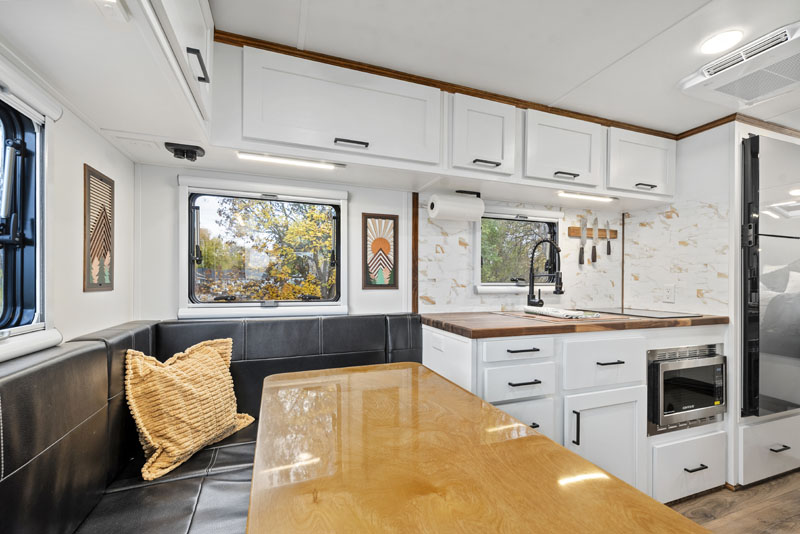
That’s quite a statement. Why do you think the non-slide X12 will overtake the triple-slide Denali 3S in sales?
The X12 floor plan is the most usable in my opinion. And it has 180-degrees of windows in the rear dinette, and the one thing everyone asks for the most—a huge dry bath. The X12 dry bath is the biggest dry bath on the truck camper market. It has a 40-inch shower, tons of counter space, and the largest tank capacities in the industry. There is no camper that compares.
Lengthwise, the X12 is 12-feet on the flatbed box, but with all of the tank capacities, features, and amenities of our triple-slides—without the slides. Based on all the interest we’ve received from the little that’s gotten out about the X12, it’s going to be a hit.
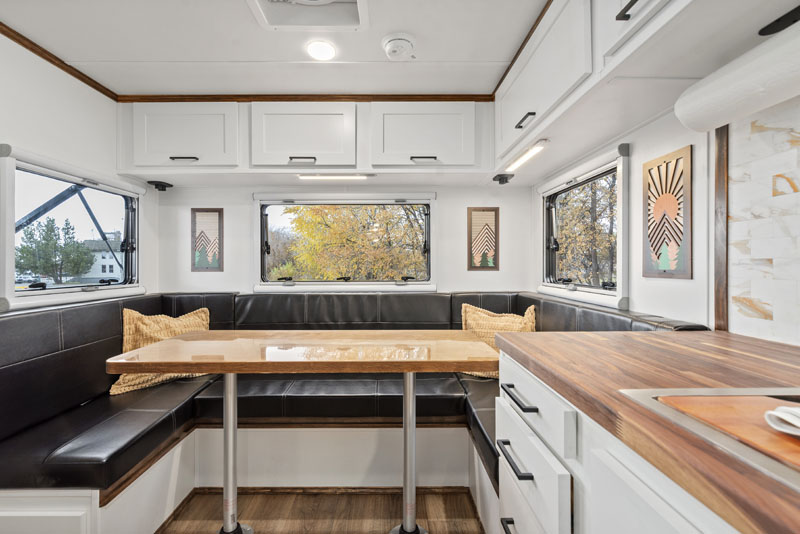
What did you need to change about the X14 floor plan to make the X12?
Everything in the X12 from the side-entry door back is the same as the X14. That’s the dinette area. Also, everything in the X12’s overcab is the same as the X14.
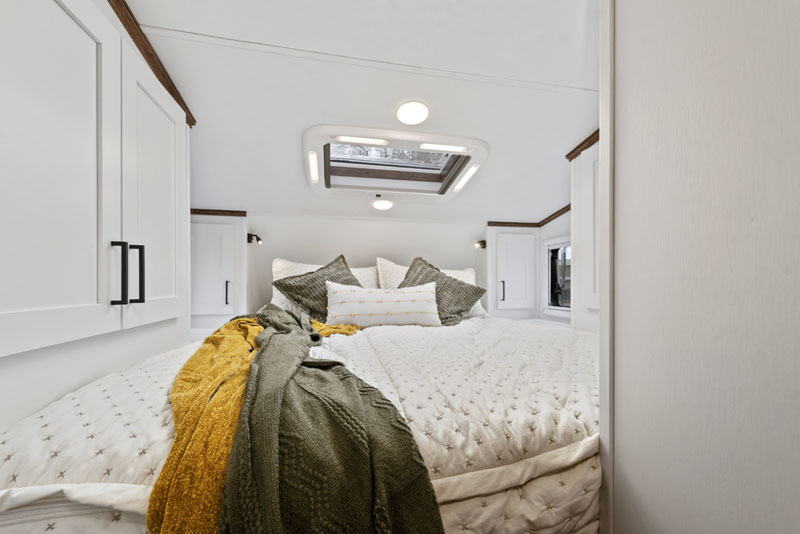
The biggest change is that the X12 dry bath, including the shower, is on the passenger’s side. On the X14, the toilet and sink are on the passenger’s side, and the walk-in shower is across the hall on the driver’s side.

The X12 shower is large enough, and the tanks are big enough, that I could literally put a bathtub in this camper (instead of a shower pan) and make it work.
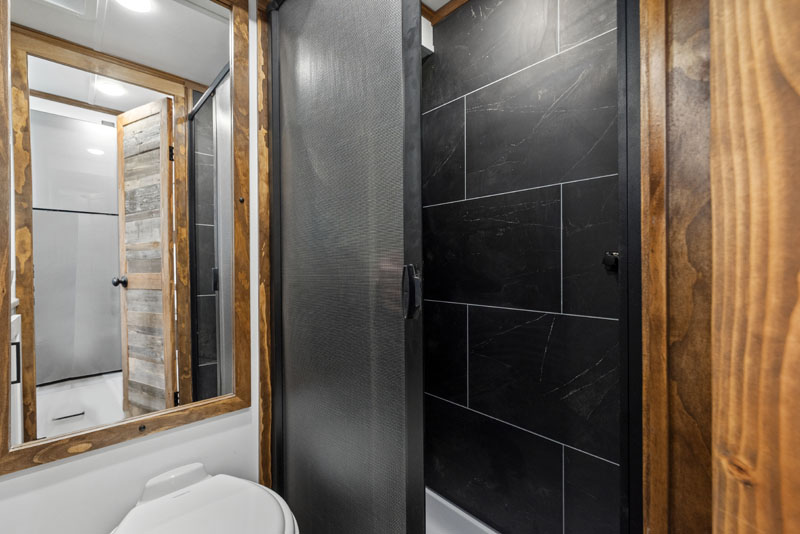
That’s insane! You could give away a free rubber duck with every order.
The duck would be a Jeep thing (laughs).
Did anything else need to change?
To make the X12 two feet shorter, we had to eliminate the pull-out pantry in the kitchen of the X14. I also did a design magic trick by pushing the bathroom countertop into the cabover (see photo below). It’s something you wouldn’t otherwise notice, but it makes a huge difference in the bathroom.

That is a neat trick. Take us inside your design and development process. Was this camper designed in CAD, on paper, or did you go straight to a prototype?
My approach to designing campers is old school. I start by taping off the planned dimensions on the floor of our factory. Then I use physical boxes and even a toilet to represent the sizes of specific features and move them around. Once I have a floor plan that works, I go into AutoCAD to design everything you can’t see. For example, where do the diesel heater and tank go?
Once that’s settled, I go into physical prototyping. During this process, I will build and tear things apart until the camper is what I envisioned. I like to use every available space for storage—even the little spaces. That comes from being an experienced truck camper owner.
Other than being shorter, is the X12 basement the same as the X14?
The height of the two basements is the same, and the tanks are in the front for the center of gravity. After that, some of the components needed to change location.
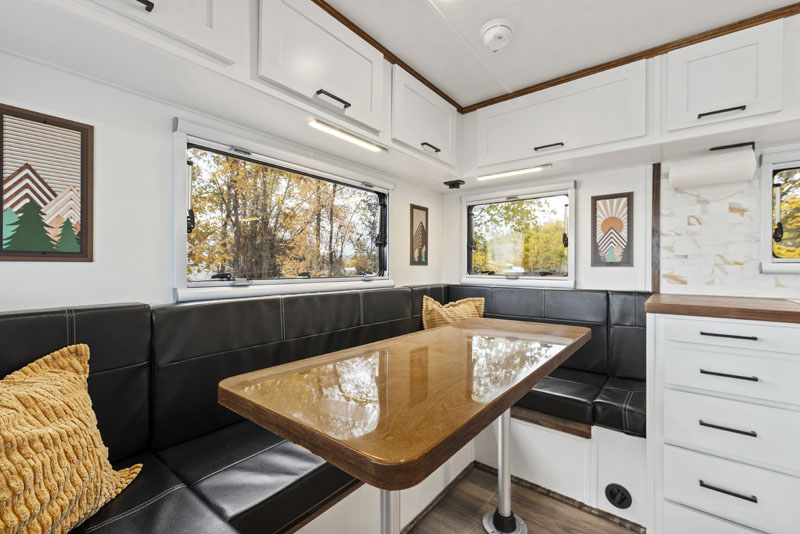
The X14 rear dinette area is available as a standard U-shape dinette, traditional dinette, two recliners, or a jack-knife sofa. And there’s an optional electric bunk for kids/grandkids. Are all these available for the X12?
Yes, all of the dinette choices from the X14 are available in the X12.
The X14 had hardwood cabinet doors, Corian countertops in the kitchen and bath, an induction cooktop, dual-pane acrylic windows with screens and blackout shades, and a queen size bed in the cabover. Is all of that retained in the X12?
Yes. Why mess up a good thing? The X14 is great. It’s just too long for some customers. All I did was shorten it by two feet.
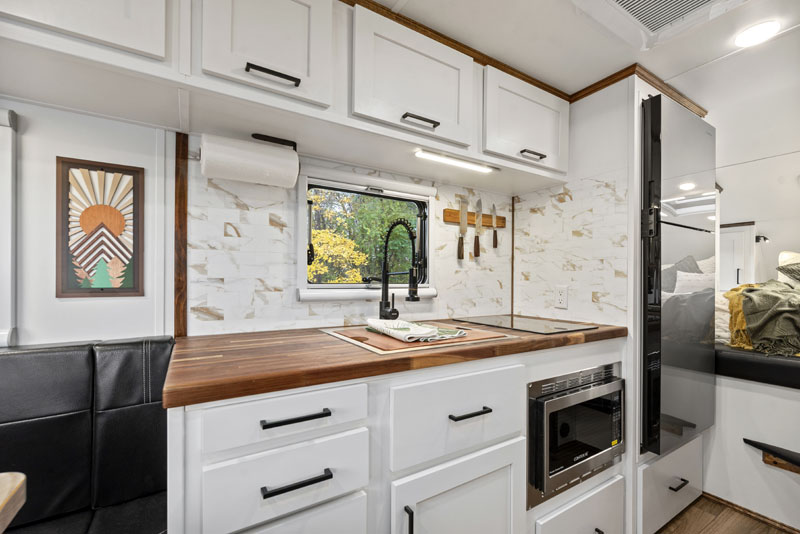
What interior finish options are available for the X12—floors, counter tops, cabinetry, walls, shower walls, etc.?
Just like all Rugged Mountain models, the customer picks from four stain colors for the trims, and chooses their flooring, countertops, and tables. The shower walls are also decided by the customer.

Above: The Timberline diesel heater in the X12
Is the X12 electric-only like the X14?
Yes, the X12 is electric-only with no propane options. We offer a diesel heater, and I can only have one fuel in the camper. Of course, you can run the air conditioner, 12-volt refrigerator, induction cooktop, air fryer, and microwave off electric, with our full solar package that comes standard in this model.
You’ve been building and delivering all-electric campers with diesel heaters for a few years now. How have they worked in the real world?
Customers who buy a Rugged Mountain flatbed truck camper are folks who want it all. They want all the options and the most possible capacities so they can be off-grid in comfort for as long as possible. That means 90 percent of them don’t want a generator and don’t want propane. What they want are huge lithium battery systems, huge solar panel systems, and highly efficient onboard electrical components.
With our large holding tank capacities, the only downfall was having to fill the propane. It makes sense to be all-electric, and the rest of the industry is starting to move that way.
I’m an electrician by trade, and long thought going all-electric wasn’t cost-effective. But once you go all-electric with the size and capabilities of the battery and solar systems we install, it’s hard to go back. Not knowing how going all-electric will work is what makes people want to stay with propane.
If you could run your air conditioner eight hours off-grid, why wouldn’t you? It’s true that a good lithium battery system is expensive. But, if you’re already spending $100,000 on a truck camper, what’s another few thousand to give you all the lithium battery power you could need?
That’s true, but it’s also true that we’re talking some serious money.
That’s the Rugged Mountain buyer. They want the best.
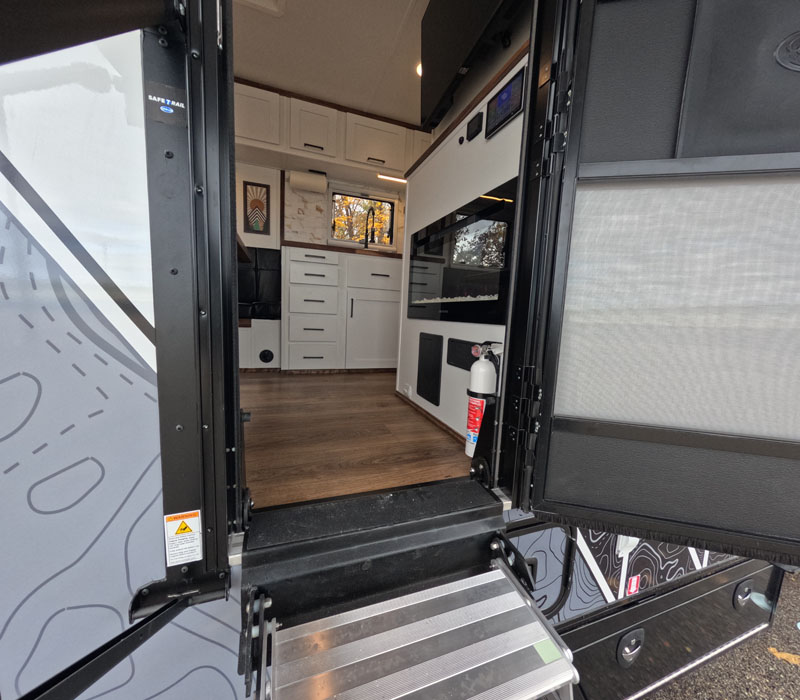
Have you maintained the X14’s continuous flat floor—no dinette step—in the X12?
Yes. At Overland Expos and RV shows, people often say our campers look very tall. First, our Class 5 trucks add some height. And second, our competitors would be the same height if you put them on a standard flatbed. And third, I don’t put a boxed step inside our campers where you can trip and fall. Nearly everyone who’s camped with a unit with a boxed step inside has tripped into that space. I have two kids and didn’t want that hazard in my campers.

By maintaining a continuous floor, and raising the entry to that level, we eliminate the interior box step and gain 100 percent of the interior floor space. Torklift and I worked on the aluminum GlowStep system together. With the added support legs, the GlowSteps are exceptionally sturdy. There’s no flex. We also include a MORryde telescoping handrail for additional safety and comfort.

The X14 is built for four-season capability, including a heated basement and open-cell polyurethane spray foam insulation. Is the X12 built the same way?
Yes. From the spray foam insulation to the core structure and overall quality, everything is identical in all of our builds.
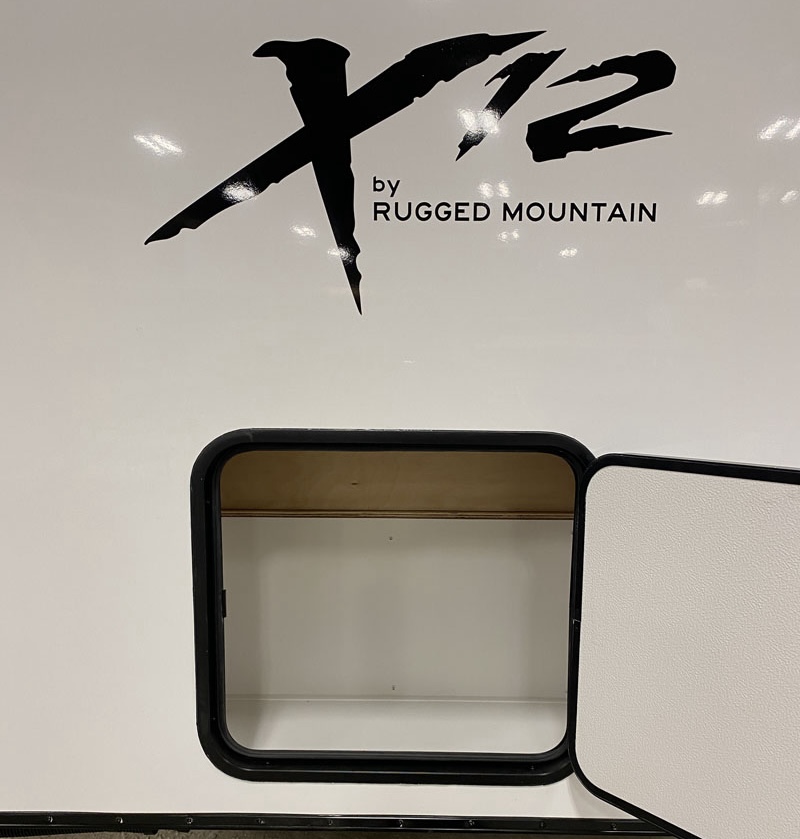
What’s the rear compartment door on the rear of the camper? Is that storage?
That’s a 22 inch by 24 inch door to a storage compartment. We would offer a larger storage compartment, but there’s no drop-down or hangover on the X12 or X14. This is how we ensure that the X12 and X14 are compatible with the majority of flatbeds and even gooseneck trailers.
The X12 sewer drain is on the side. The only thing hanging in the back is the exhaust pipe for the diesel heater, which we’ve been toying with, also taking out the side.

The X14 has 80 gallons of fresh, 76 gallons of grey, and 35 gallons of black. What are the tank sizes in the X12?
Exactly the same. Storage is the only thing that was lost in the basement between the X14 and X12. As a design principle, we put everything in the basement including batteries, the electrical system, and the diesel heater. Where other companies take up the space under your dinette seats, or under your kitchen sink, or other storage areas with components, everything in a Rugged Mountain is in the basement. We can give you up to 1580Ah of lithium batteries in the basement without having to take up any interior storage.
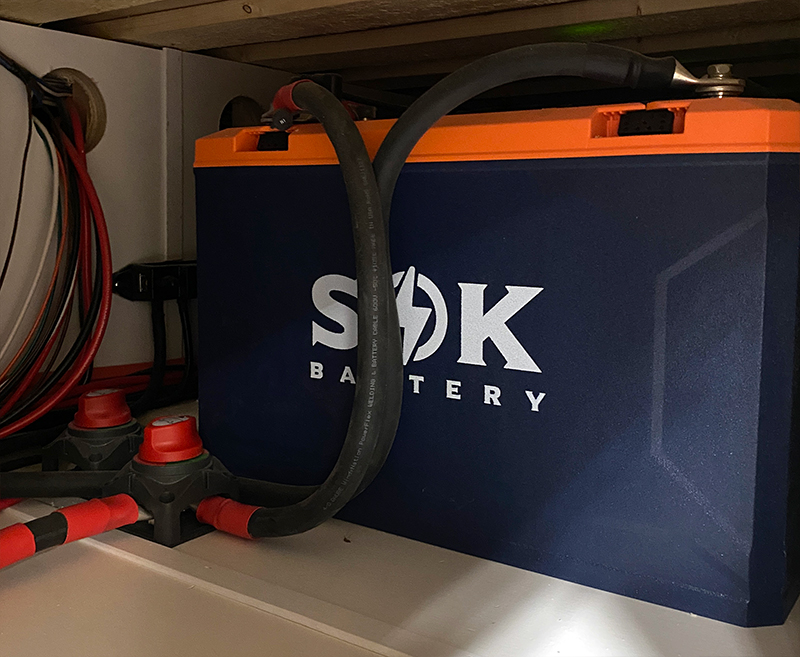
Can you access the batteries and other components and systems in the basement?
Yes. The access doors on the X12 are 12.5 inches tall, but it can be done. We do our best to give you full access to heat exchangers and batteries. The X14 has two compartment doors to get to them easier.
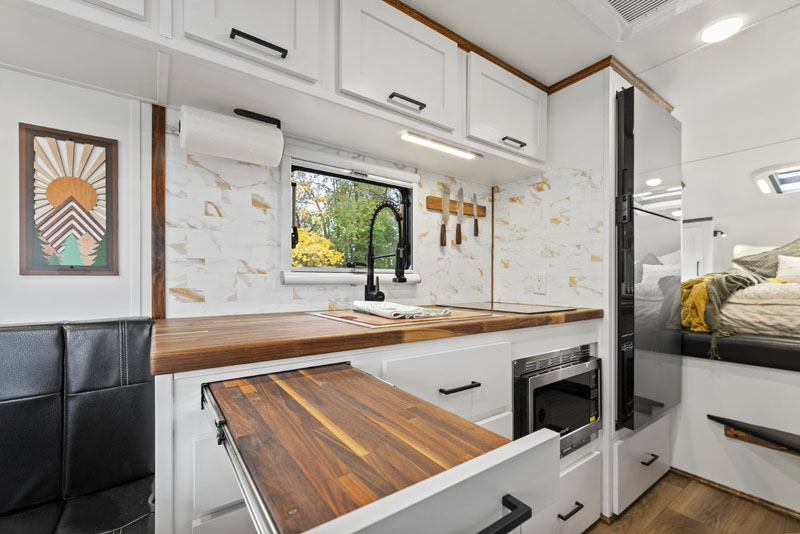
What furnace, water heater, and refrigerator did you choose for the X12?
X12 customers have the same options as the X14. There’s a 12-volt 8 cubic foot refrigerator standard, and you can go to a 10 cubic foot refrigerator. The pictures show an optional 10 cubic foot refrigerator.
We have different refrigerator brands you can choose from, but all are 12-volt refrigerators. The X12 also has an optional fireplace and a 40 inch television.
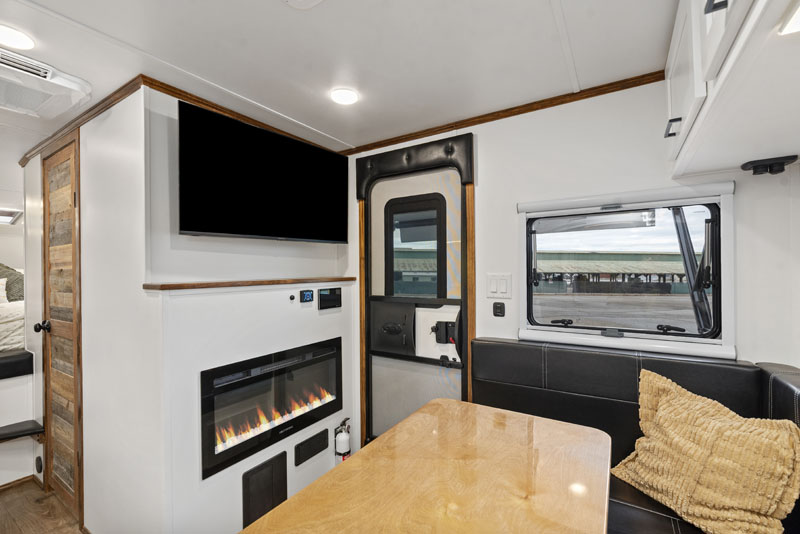
What air conditioner did you select for the X12?
In our X12 base model, we offer a Dometic rooftop air conditioner. In our prototype model, we installed a Houghton AC/heat pump with the optional soft start. It’s hard to beat the Houghton with the heat pump. When you have an all-electric camper, you can use the heat pump and/or the electric fireplace and/or the diesel/electric heater for heat. It’s an unbeatable combination. The Houghton, with or without the soft start, is an option in all our models.
It’s interesting that you chose a 120-volt air conditioner over a 12 or 48 volt model. Given that you’re already going high-end, why choose the Houghton?
I’ve tested many air conditioners. Even though the Houghton is 120-volts, it’s still more efficient than the others I’ve tested.
Here’s what a lot of people don’t understand about the size and capability of the battery, solar, and electrical systems we install in our campers. First, our customers often leave their inverters on 24 hours a day. If you only have 400Ah, that could be an issue. But with 900 to 1,580Ah of lithium and 1,200 to 1,600 watts of solar, plus DC-to-DC charging when you drive, there are no issues. Even running the Houghton 120-volt air conditioner for hours on end with the door open, there are no issues. I do it all the time at the summer Overland Expos and RV shows.
Slide-in truck campers simply don’t have the space to have that much onboard power. It’s hard to fit huge battery banks because there is no space without taking up the storage under the dinette seats and other areas. My flatbeds excel because of the huge battery banks and holding tanks. These options are simply not attainable in a standard truck camper.

You’re talking about nothing less than a paradigm shift in how people think about battery, solar, and electrical systems in truck campers. What are the standard and optional solar and battery systems for the X12?
The standard X12 battery bank is 316Ah. The standard solar panel wattage is 1200-watts.
The X12, like the Denali 3S triple-slide, can fit up to six 200-watt Go Power panels. That’s 1,200-watts of solar on the roof. The Go Power panels were originally designed by John Zamp and are our recommended solar panels. In the basement, there’s space for up to 1,350Ah of lithium.
The X14 features a standard Victron electrical system, including a Victron Multiplus inverter, GX touch panel, 50A DC-DC charger upgradable to 100A. What is standard/optional for the X12?
The standard X12 electrical system consists of one 316Ah lithium battery, a Victron 3000-watt multiplus inverter, a Victron GX touch 70, one 50 amp DC to DC charger, and a Victron Cerbo GX MK2.
The optional X12 electrical system includes an additional 50 amp DC to DC charger and more battery options.

Where are the controls and monitors in the X12?
The control monitors are located to the right of the entry door. You’ll see two touch screens. The first is for the diesel heater. The second is for the Victron electrical system. Underneath those control monitors are the 12-volt fuses and 120-volt breakers.
Tell us about the diesel heater that you are using in the X12.
We have recently switched from the Timberline 2.0 system (dual zone system) to the Timberline 1.0 system (single zone system). The 2.0 system has dual control zones and a bigger control monitor touch screen, but the two systems compete with each other in a camper.
The Timberline 1.0 doesn’t have this challenge, is a simpler system, and works exceptionally well. Airstream is using the Timberline 1.0 in their trailers. We still have two heat exchangers and four ducts, but only one zone. It’s a good trade-off.

Are there any options for the exterior graphics package?
Yes. You can get the graphics package shown in the photos with three color options. You can also delete the graphics package and get a credit.
Where is the center of gravity on the X12?
The center of gravity for the X12 is 49” from the front wall.
Center of gravity is a big deal for me because I tow. An F-550 can easily handle the weight of an X14 or X12, but if you’re pulling an enclosed trailer with a car inside like I do, weight distribution and balance become critical. I have a CDL, so if I’m overloaded or unbalanced, I can get in trouble. For most folks, that’s not a concern since they’re not towing. With a Class 5 F-550 or 5500 and a flatbed, it’s even less of an issue because those trucks can handle the load without being overloaded.
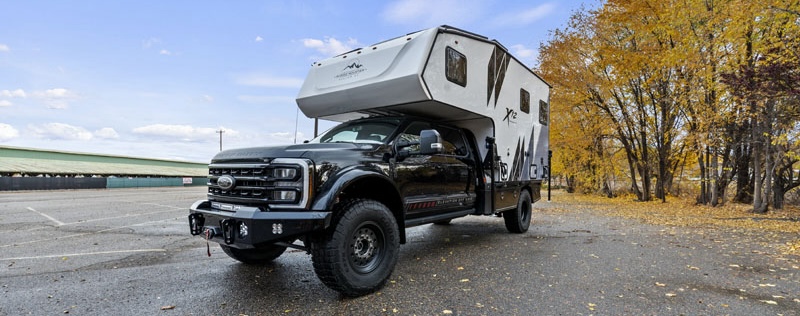
What is the base dry weight of the X12, and what does that include?
The base dry weight of the X12 is 4,935 pounds.
To determine that, I started with the X12 in the photos—which is fully loaded with 1,580Ah of batteries, 1200-watts of solar, full diesel fuel, and almost every available option. From that fully equipped dry weight of 5,280 pounds, I subtracted the weight of the optional equipment to arrive at the base dry weight.
That said, Rugged Mountain has never actually built a true base model. It’s tough to compare our base dry weights to our competitors because their numbers often don’t include things like an air conditioner, batteries, solar panels, and our long list of standard equipment. Some even separate the weight of their air conditioners on a sticker inside a closet. It’s not an apples-to-apples comparison.
What’s even more egregious are the comparisons on price. Rugged Mountain campers include everything that comes standard. Again, our campers come standard with batteries, solar panels, air conditioners, and many other items listed as optional by the competition. We can do this because we sell factory-direct and we build every camper exactly how the customer orders it. In contrast, our competition builds campers for how dealers order campers, who then upsell items like batteries, solar panels, and air conditioners at considerable profit. Because we sell direct, there’s no dealer mark-up—just real factory-direct pricing, real factory-direct weights, and a ready-to-camp product with a warranty we stand behind.
“Our campers come standard with batteries, solar panels, air conditioners, and many other items.”
By Rugged Mountain RV’s own requirements, the 5,325 pound dry X14 flatbed requires a flatbed Class-5 truck. What truck is required for the X12?
Given the 4,935 pound weight, we are recommending a Class 5 F550 or 5500 truck.
It’s important to consider our industry-leading tank capacities. For example, you may be able to match a particular camper to a one-ton, but the minute you fill the fresh tank, you’re adding 1,000 pounds and overloading the truck. We tell you the truck you need with the options you select, a full fresh tank, and your food and stuff because we care about your safety.
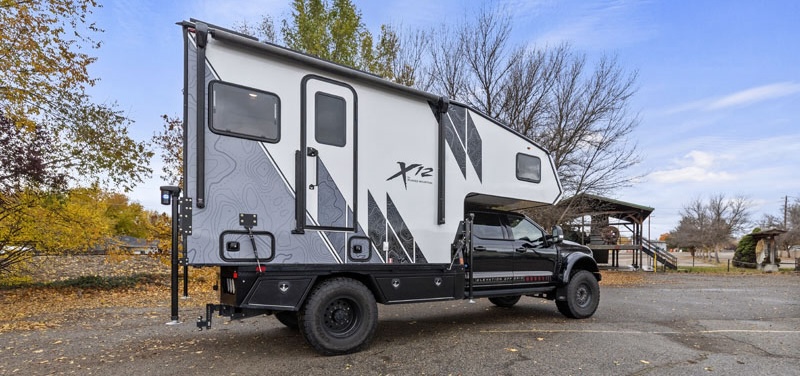
What flatbeds do you recommend for the X12?
There are lots of options. We do not push our customers in any one direction. Our campers have a cutout for the headache rack used on many different flatbed brands and designs.
We have put together several campers using a CM brand RD 11-foot steel flatbed. These beds are often between $5,000 and $7,000 installed. You can also get the CM AL RD 11-foot aluminum flatbed that is $10,000 to $11,000 installed. Please contact us before you make a flatbed choice, as there are many important considerations.
Other popular options are custom flatbeds from Bowen Customs in Colorado, Sherptek in Oregon, and Adrenilin Industries in Utah. I have customers with beds from all over the place. As long as you work with us in advance, there are no problems.
Will we see another X camper? Maybe an X10?
We probably won’t go smaller than the X12 in the flatbed X-series. If I do shorter, I’d go with a slide-in, possibly above the rails. The downside to that approach is that you lose the tank and battery capacity that makes the flatbed campers the best in the marketplace.
What I can tell you is that there are more innovative campers to come. I have revamped and modernized the Granite 11RL, which is in development, and that is going to flip the script.
What’s the Rugged Mountain X12 warranty?
Rugged Mountain has a two year structural warranty.
Our warranty stands above the competition because we sell direct—you always deal with us personally. That means we can source parts quickly and, when needed, coordinate repairs with a local facility without delay. Compare that to going through a dealer who has to relay everything to the manufacturer, and it’s clear why buying direct is the better choice. We know our customers, talk with them regularly, and have even camped alongside many of them in our own Rugged Mountain camper.
That speaks volumes. What’s the X12 MSRP for base and fully-loaded versions?
The Rugged Mountain X14 base MSRP is $95,000. The fully loaded model in the photos is $103,418.

When will the X12 be available?
The X12 is available to order immediately. We get emails several times a week about this camper. I believe it will be our hottest model from all the inquiries and interest. I expect we’ll get busy with orders quickly and get backed up. Right now, we’re six months out. If you want a Rugged Mountain in the near future, contact us as soon as possible.
As a side note, we will be building campers in model runs next year. That means we will be building a run of Denali 3S triple-slides, followed by a run of X12 non-slides, and so on. If you want a particular model, we will put your name on a build slot during these model runs.
Right now, I’m slowly building up our production crew and improving efficiencies for this expected surge. I am not sacrificing quality to build more campers.
“We will also have two never-before-seen Rugged Mountain campers at the Florida Super Show. Stay tuned.”
Is there anything else going on at Rugged Mountain that you’d like to share?
There are lots of changes happening here. I recommend following Rugged Mountain on social media. We have things coming that are going to push the industry forward.
We will also be at the Florida Super Show in Tampa this January. I will be bringing the X12 to that show. It will be for sale at the show, and I do not want to take it home.
And if that’s not enough, we will also have two never-before-seen Rugged Mountain campers at the Florida Super Show. Stay tuned.
For more information on Rugged Mountain, visit their website at ruggedmountaincustomrv.com. Click here to get a free Rugged Mountain brochure.
